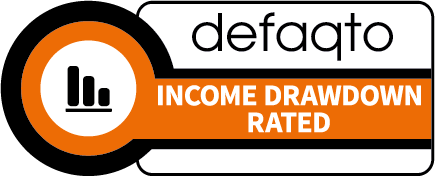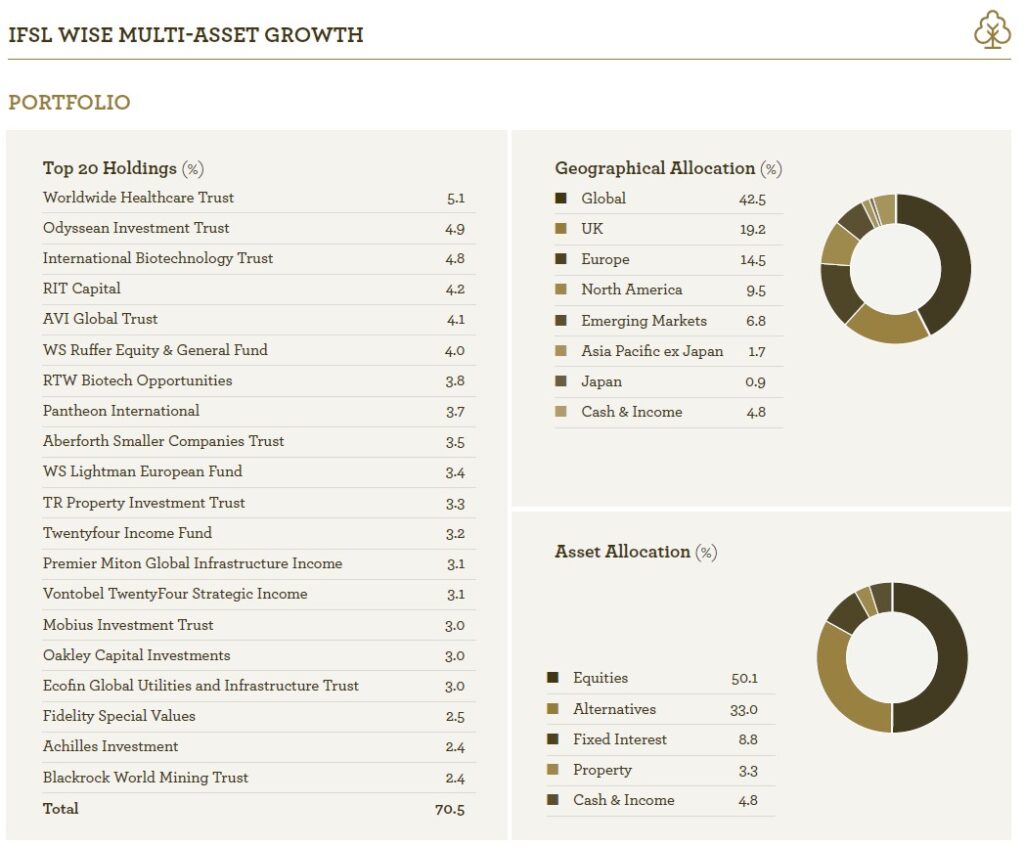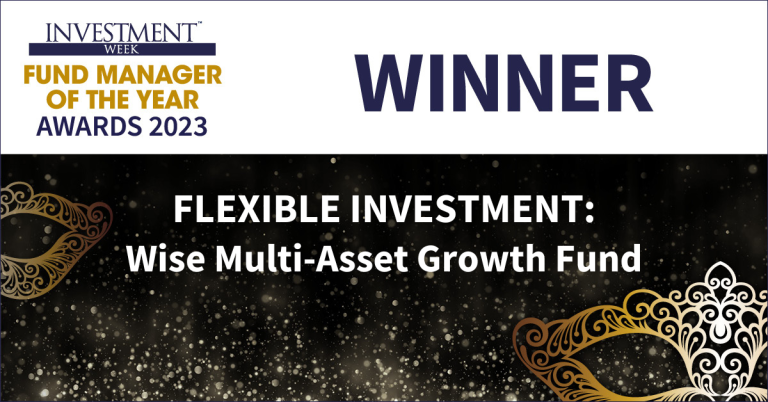Wise Multi-Asset Growth
Fund Ratings




Investment Objective
The investment objective of the Fund is to provide capital growth over Rolling Periods of 5 years in excess of the Cboe UK All Companies Index and in line with or in excess of the Consumer Price Index, in each case after charges.
Fund Attributes
- Aims to provide long term capital growth (over 5 year rolling periods) ahead of the Cboe UK All Companies Index and inflation.
- Specialised focus on investment trusts across asset classes.
- Adopts a value bias investment approach.
- Focus on high-quality funds and investment trusts investing in out-of- favour areas.
- Preference for fund managers with a disciplined, easy-to-understand investment process.
Investor Profile
- Seek capital growth over a long time frame.
- Accept the risks associated with the volatile nature of an adventurous multi-asset investment.
- Plan to hold their investment for the long term, 5 years or more.
Key Details
| Target Benchmark | Cboe UK All Companies, UK CPI |
|---|---|
| Comparator Benchmark (Sector) | IA Flexible Investment |
| Launch date | 1st April 2004 |
| Fund value | 62.1 million |
| Holdings | 38 |
| Valuation time | 12pm |
- Past performance is not a guide to the future
- Data as at 31st October 2025
Investment Portfolio - October 2025


- Past performance is not a guide to the future
- Data as at 31st October 2025
- Wise Funds Ltd are delighted that our Wise Multi-Asset Growth Fund was announced as winner of the Flexible Investment Category at the prestigious Investment Week’s Fund Manager of the Year awards.

Share Class Information
| | B Acc (Clean) | W Acc (Institutional) |
|---|---|---|
| Sedol Codes | 3427253 | BD386X6 |
| ISIN Codes | GB0034272533 | GB00BD386X65 |
| Minimum Lump Sum | £1,000 | £100 million |
| Initial Charge | 0% | 0% |
| IFA Legacy Trail Commission | Nil | Nil |
| Investment Management Fee | 0.75% | 0.50% |
| Operational Costs | 0.14% | 0.14% |
| Fund Management Costs | 0.22% | 0.22% |
| Ongoing Charges Figure 12 | 1.11% | 0.86% |
All performance is still quoted net of fees.
- The Ongoing Charges Figure is based on the expenses incurred by the fund for the period ended 31st October 2025 as per the UCITS rules.
- Includes Investment Management Fee, Operational costs and look-through costs.
The figures may vary year to year
Fund Commentary - October 2025
Despite good headline performance numbers across most equity markets, October saw the most volatility since the announcement of global tariffs by President Trump in April. We have highlighted for some months that high valuations left very little room for error, and last month a number of developments began to dent investors’ seemingly Teflon-like optimism. These were merely dents, however — signalling potential areas of weakness and calling for caution rather than a full scale retreat.
The main source of October’s volatility was, once again, tariff related. The threat of escalation in the trade war between the US and China, triggered by Chinese controls on exports of rare-earth minerals and imports of US chips (retaliation to US tariffs) and counterthreats from President Trump, spooked markets. The fear of an intensifying conflict triggered sharp falls in equities and cryptocurrencies. It then became clear that negotiations remained open, culminating in a meeting between Presidents Trump and Xi in South Korea at the end of the month, where a framework for future deals was announced, thus averting, in the short term, the worst-case scenario. China appears, so far, to be the sole country willing and able to stand up to Trump’s tactics and is managing to emerge relatively unscathed. Equities recovered quickly, but cryptocurrencies, driven more by sentiment than fundamentals, failed to regain their losses, possibly signalling that the dent is turning into a crack.
Staying with sentiment driven assets, gold also endured a volatile month. It began by breaking USD4,000 an ounce for the first time ever, just six months after surpassing USD3,000 and only six weeks after USD3,500, a clear sign of accelerating momentum. It touched near USD4,300 by mid-month, amid news of global queues waiting to buy gold coins and bars, and websites such as the Royal Mint struggling to keep up with demand. In the end, gold finished the month around USD4,000. Whether this represents a pause for breath or another example of market froth being purged remains to be seen.
The final major sign of market fragility in October was a handful of defaults in the private credit sector, mainly fraud‑related. Private lenders have supplanted traditional banks in large areas of the credit market, making financing more accessible for many companies, but the concern is that too much capital has gone to lower quality borrowers, and an economic downturn could trigger a sharper rise in defaults than expected. Thus far the defaults have been driven by fraud rather than indicative of broad economic distress and limited to specific sectors such as autos. Also, although private‐credit deals are less transparent than bank or public credit lending, they carry less systemic risk. Interestingly though, US banks reporting Q3 results showed a reduction in loan write-offs on their balance sheets suggesting we are not yet at a point of broad economic deterioration. It remains an important market to monitor, however, as it often acts as a canary in the coalmine.
On the macroeconomic front, with the US federal government shutdown entering its fourth week at month end, only inflation data was released at 3 %, which was below expectations. This opened the door for a rate cut by the US central bank, mindful of a weakening jobs market but it emphasised that future cuts are not guaranteed at future meetings. Markets expected the cut, and this helped support risk assets in the lead up to the meeting at month-end, despite earlier volatility. Equally, in the UK, weaker than expected inflation also boosted the chances of a rate cut by the Bank of England before year end to address anaemic growth. However, the looming UK Budget at the end of November introduces uncertainty: a sizeable fiscal hole may force the Chancellor to break manifesto tax pledges, and the Bank may opt for a pause until after the Budget. Europe continued to see headwinds, with political uncertainty in France and weak industrial production in Germany. Japan fared better after the appointment of a new prime minister, Sanae Takaichi, who promises market friendly fiscal stimulus and helped push Japanese equities to the top of the global leaderboard for the month and year-to-date.
At the company level, Artificial Intelligence (AI) remains the dominant theme and a flurry of deals between AI providers and critical component suppliers (chips, servers…) was announced. So far, investors are absorbing these announcements, helping drive Nvidia to an all-time record of USD5 trillion market capitalisation (roughly the size of the whole Japanese economy!). It is noteworthy, however, that market reaction to earnings reports from large tech companies is increasingly signalling a reluctance to support projects with low visibility of future earnings enhancements. This is another sign that high valuations are demanding greater selectivity.
In October, the IFSL Wise Multi-Asset Growth Fund was up 3.5% ahead of the CBOE UK All Companies Index (+ 2.9%) and in line with its peer group, the IA Flexible Investment sector (+ 3.5%). In what feels like a period of transition where the economy is hard to read and investor sentiment shows signs of frailty, we are pleased that our more idiosyncratic ideas, driven by specific catalysts rather than macro factors, are performing well. Nearly half of our outperformance last month was driven by our healthcare investment trust holdings. Accelerated acquisition activity among biotechnology companies by large pharma continued to boost both International Biotechnology Trust and RTW Biotech Opportunities which held positions in companies (Akero and Avidity) acquired during the month (at premiums of 17 % and 46 % respectively). This takes the year’s total number of acquisitions in the International Biotechnology Trust portfolio to nine, and six in the RTW portfolio, signalling the potent combination of strong innovation, cheap valuations and acquisition urgency by large pharmaceutical companies needing to replenish their stocks of patents. Meanwhile, in private equity, ICG Enterprise announced another realisation at a premium — one of six in its top holdings this year — aiding its discount tightening. Our other private equity holdings saw similar moves in their discounts.
The primary detractors were in the mining sector, reflecting the volatility in precious metal prices.
It was a busy month for portfolio activity. We exercised caution, taking profits in several strong performing positions, including Jupiter Gold & Silver earlier in the month. Following the surprise departure of its managers, we exited our position in the Schroder Emerging Markets Value Fund and replaced it with another value-oriented manager on our reserve list: Pacific North of South Emerging Markets Equity Income Opportunities. We also diversified our holding in the Schroder Global Recovery Fund by switching some exposure into the Brickwood Global Value Fund (run by managers we have previously invested with in their previous firm). We added a new position in the CVC Income & Growth trust, a loan manager known for due diligence discipline and a strong default-avoidance track record. Finally, we topped up Achilles Investment Company, an activist manager in the investment trust space, which we believe is well positioned to generate attractive returns despite uncertain macro conditions. Overall, our cash levels remained higher than average, leaving some powder dry to take advantage of future opportunities.

